Often when you visit small galleries which are staging a joint exhibition of paintings done by a small number of artists, you like some and are disappointed with others. I was in Portugal last week and my visit coincided with an opening of a joint exhibition at a local gallery and I was fortunate to have received an invite which coincided with my short break away.

The exhibition was at the ArtCatto gallery in the heart of the Algarve town of Loulé. ArtCatto was the brainchild of Gillian Catto, who after 30 years as the owner of an internationally recognised and respected gallery in London, decided to settle in the Algarve and she opened ArtCatto in 2011. Gillian Catto developed a reputation, which is second to none. She was responsible for launching the careers of artists who have subsequently become household names, such as Jack Vettriano. His solo exhibition at her Gallery helped to create a global demand for his work, which skyrocketed in value virtually overnight.

The gallery is divided into a number of small rooms, each featuring the work of one artist. In one of these rooms there were six exquisite works of portraiture by the Chinese artist, Shen Ming Cun. Shen was born in 1956 and graduated from the University Art College of Guangxi in China, where he is now a professor of European Art. He is highly respected as an official artist for the Chinese Government, and has exhibited in Hong Kong, Beijing, Singapore, New Zealand, and Britain.
Shen Ming draws his inspiration from the ancient traditions, crafts and culture of the tribes of the Miao, Yao and Dong of the remote GuangXi region of China. There are large changes in China which is causing a massive strain on the ancient way of life in these small village communities and as the young people leave the villages to seek work in the large cities one has to wonder how long these cultures can survive.

Each tribe has a quite unique tradition in dress and adornment from the other. The young girls sew everything entirely by hand and their jewellery is crafted in the village.
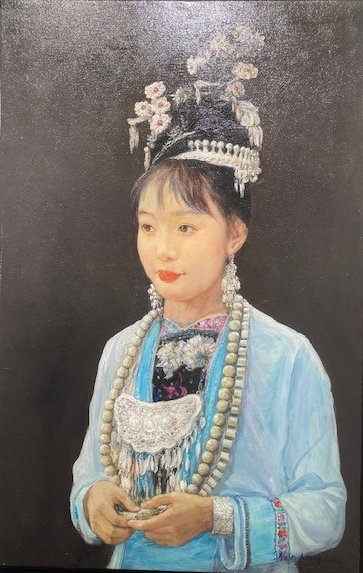
Shen’s paintings have come to focus on capturing, distilling and representing the inimitable customs, dress and heritage of these minority tribes of Southern China. His empathy and admiration of these tribal people is well-defined in his paintings, which possess a lyrical beauty, dignity and grace. In fact, his paintings have been likened to a kind of visual poetry in their way they communicate to the viewer a variety of emotions and to entice the spectator into their worlds.
Shen’s paintings capture the chromatic vibrancy of the costumes and ornate silver jewellery with a lightness and confidence that has undoubtedly led to his success. Their adornments are genuine symbols of the wealth, religion, ritual and national consciousness that shape their lives. It is truly remarkable to witness the intimate moments that he often portrays which provide an atmosphere of invitation and intrigue for the viewer. Shen explains his inspirational art:
“…I have spent a long time researching the richly colourful cultural heritage of the Yao and Miao nationalities and the Dong minority of Southern China. Over the years I have lived amongst them and become friends with these beautiful people who radiate pure goodness and a simple love of life. Cultivating their ancestor’s achievements, they turn life into immortal art…”
On entering another room I came across some fascinating works of art by Pedro Guimares. Pedro Guimarães, born 1974 in Guimarães, Portugal. From an early age, Pedro was fascinated by art and design, resulting in an exhibition at the age of sixteen at the Youth Centre in Braga. The success and impact of that show confirmed his career as a professional artist and as a result he set up his studio in Guimarães to continue his practice.

In 2011 he moved to Cantabria, Spain, having the opportunity to exhibit his work there. Back in Portugal it was in Guimarães that he set up his atelier. There he devoted an increasingly greater amount of time to plastic arts until it finnaly became his exclusive activity. Since then, Pedro Guimarães participated in several individual and collective exhibitions in Portugal and abroad with an intense and always innovative artistic production.
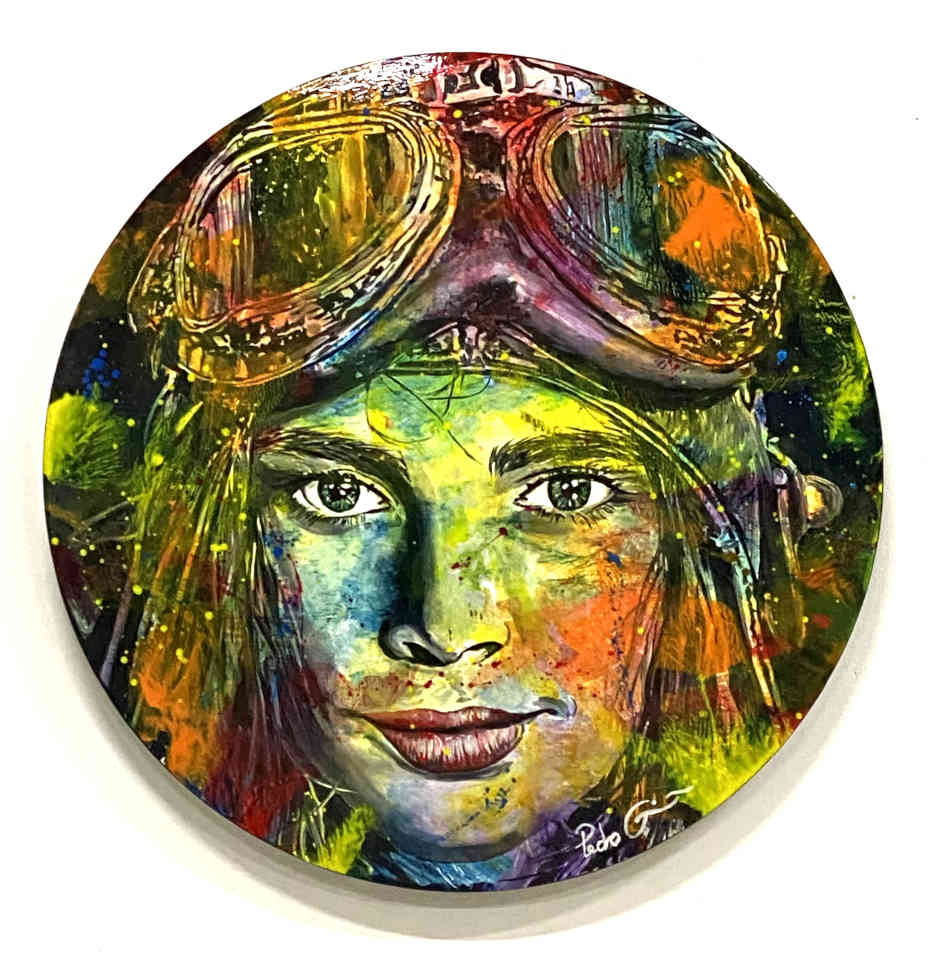
Pedro Guimarães’s work is based on a conceptual language created by him, which he defines as:
“…the true transparent reaction of our consciousness with the synapses that make us unique and influence the direction of our concepts, associating colours and shapes…”
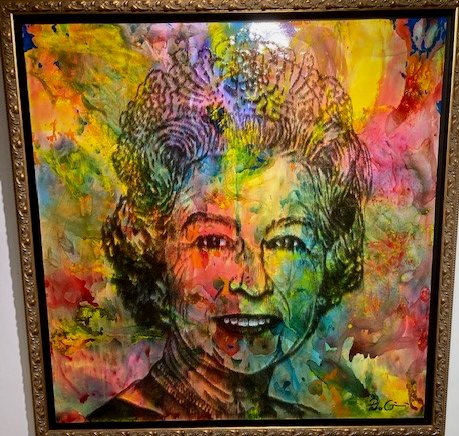
Enjoying a wide creative freedom, Pedro Guimarães uses various resources and materials. One of the strangest and probably the most time-consuming work was a portrait entitled Untouchable. In loving memory of Queen Elizabeth II. For this work, Guimares used a technique which he terms “Untouchable” which gives the work a unique content, curious, and some might say disarming. Standing before the portrait you see nothing unusual but……….

………..stand to the side of the portrait and when you look again you realise the artwork comprises of numerous pins (180,000 pins) that forms the figure into a three-dimensional shape. You only notice the pins when you view the work side-on.

The painting of his, maybe I should say the three paintings of his, which fascinated me was entitled The Three of Us. I suppose the portrait(s) fall into the category of being a Trompe L’oeil depiction. As I stood in front of this strange slatted painting I saw a depiction of Princess Diana. At first I could not fathom out the reason for the vertical slats.

However when I moved to the left and viewed the painting at a 45 degree angle the image of Diane disappeared and as if by magic, the depiction of her son Harry came clearly into view………

……and when I moved to the right of the painting an image of William gradually appeared. Yes, I know it was just a work of trickery but it was very cleverly done.

On entering the gallery, you were greeted by a wash of bright colours which extended along the walls of the passageways. The paintings reminded me of some of the colourful seascapes I saw at the Joaquín Sorolla Museum in Madrid. These artworks at the ArtCatto gallery were by the English artist Richard Gower.

Richard Gower was born in West Yorkshire in 1962 and is a fine artist who is known for his contemporary oil paintings rendered in his characteristic impressionistic style. At the age of seventeen, he studied at Batley College of Art and specialised in fine art and sculpture. He is influenced by the great artists of the nineteenth and twentieth century such as Monet, Van Gogh, Picasso, Sickert, Francis Bacon. Richard’s determination to paint and learn everything he needed to learn motivated him to study the great impressionists. Richard’s fascination with the great painters pushed his own creativity and observations to develop and fine-tune his personal ‘Reflections’ style over the years. As a young man he travelled throughout Europe on his motorbike stopping of at various cities and towns always visiting galleries and exhibitions, whilst all the time honing his artistic skills and developing his passion for painting.

The semi-abstracted, figurative compositions we see in his beach scenes have both a real sense of joie de vie but also intrigue. As observers, we are asked to conjure up narratives about these anonymous characters who are enjoying a day at the seaside and who are immortalised on his canvases.


These seaside scenes by Gower would light up any room and bring with them the hankering to leave rainy and windswept climates and visit beautiful beaches and soak up the sun.

Another room at the ArtCatto exhibition was dedicated to the artwork of Mario Henrique. Mario Henrique is an artist based in Cascais, Portugal, who graduated in Design from Lisbon’s University of Fine Arts and started his career in online marketing and web development agencies. Later on, as a creative director he recruited and led teams in Portugal, Spain and Brazil.

Of his painting style Mario explains:
“…I try to be fast and spontaneous when I’m painting – that process should be reflected in the final piece. The observer should be able to infer the physicality of the painting process, when looking at the brush strokes and paint drippings…”
“…When I throw paint, I can do it with some premeditation – but I can never really predict where the paint will actually fall on the canvas. So, my approach to painting is – in part – based on chance, on small random accidents – it doesn’t rely exclusively on my persistence or my technique.
That’s why I don’t feel completely responsible for my paintings – in the sense that, although I can answer for my initial intentions, the final…”

Mario Henrique is passionate about his work and has exhibited his work in Portugal, Brazil, Germany and the US. He says that he is forever intrigued by the subtleties and double meanings of people’s body language, expressions and looks, and he composes works centred around people. Mario uses his portraits to represent the impermanence of facial expressions and unpredictability of human movements, and paints abruptly and spontaneously in drippings and splashings.

Listed in various private collections across Europe, America and Asia, he has exhibited in galleries both locally and abroad, and was awarded an Honourable Mention for his participation in the Brasília Biennial of Contemporary Arts 2016. He was also featured in Saatchi Art’s Inside The Studio.
At the ArtCatto’s exhibition, there was also a selection of sculptures both with a modern style and a classical one.
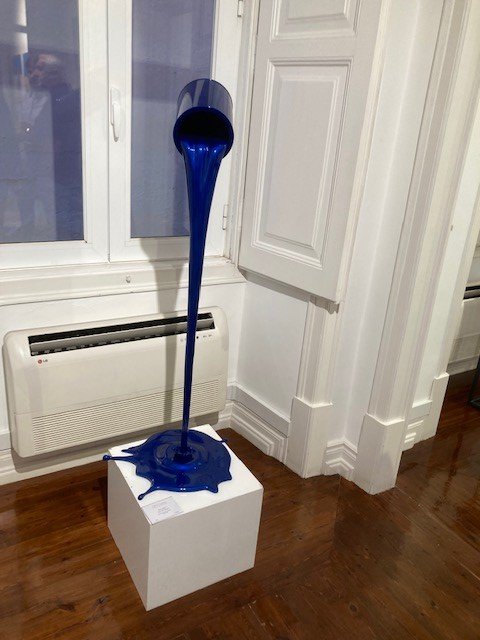
Sculpture Flow by Paul Sibuet
Paul Sibuet, a French visual artist, was born in 1986. He was trained in Design and Art and his work has been submitted at numerous competitions, in Tokyo and Paris. He has now broken free from the techniques he was taught by exploring his own perceptions of the object and volumes, and in so doing so he has created his own signature. He lives today in Lyon and exhibits in particular in Geneva, New York and Venice.


At the rear of the gallery there is a narrow outdoor passage way which was lined by statuettes by Anneke Bester. Anneke Bester is a South African born artist who now considers New Zealand her home country. She not only exhibits in New Zealand but also regularly in Portugal and Dubai. Her body of work is a combination of one-off, delicately cast, bronze sculptures as well as editioned works. Anneke’s work focuses on celebrating Femininity in all its aspects. She sculpts gorgeous female forms in sensual poses. She develops the female energy of nature and depicts the female forms as daughters of mother earth in her most recent work.poses. She sees the female in its internal beauty and its core driving force that only a female sculptor can explore to its full extent.
If you are ever in the Algarve you should try and visit the ArtCatto gallery which lies on the town’s main street, across from the large Municipal Market Hall,










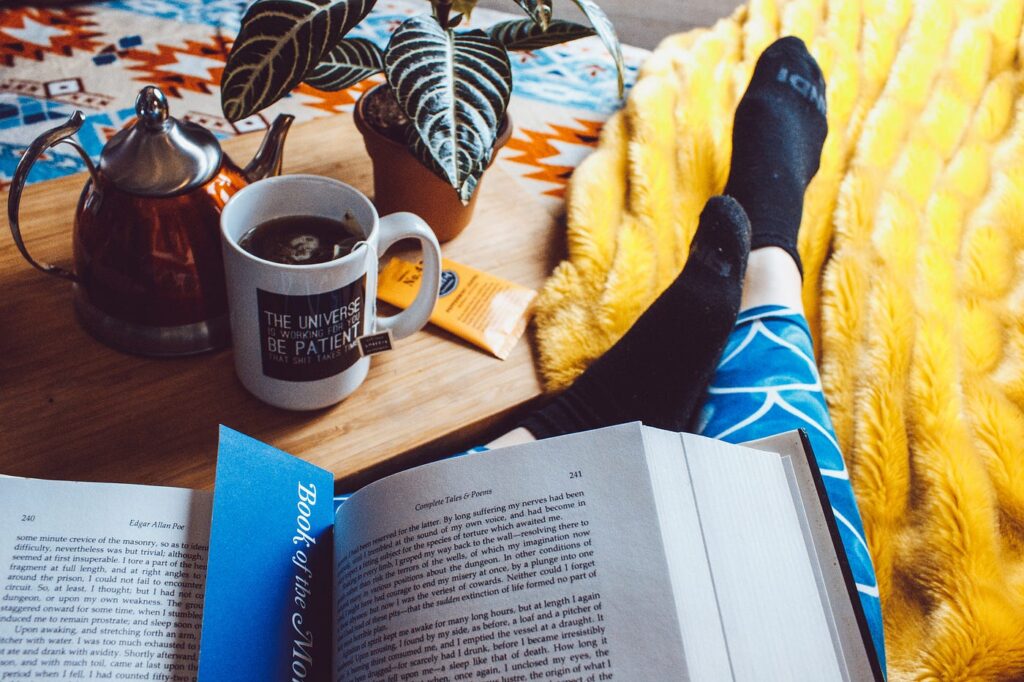
More Stories
How a Local Production House Can Elevate Your Brand’s Message
Why Sapphire is a Top Choice for Birmingham Engagement Rings
Cherish the Magic: Capture Your Little One’s First Christmas with a Festive Mini Photoshoot